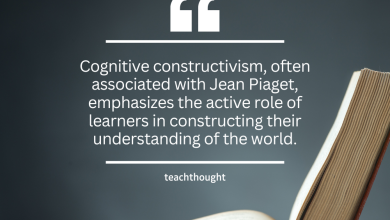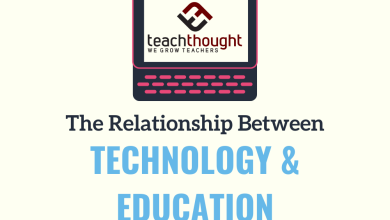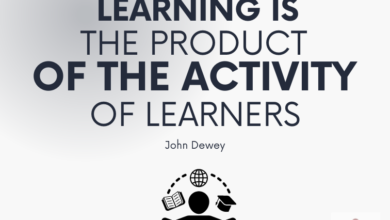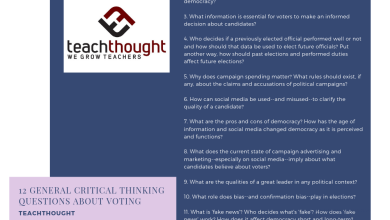The Problem With Predicting The Future Education –
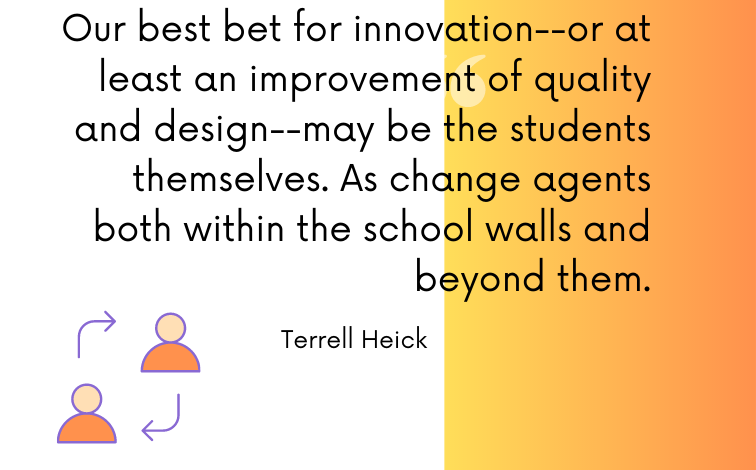
With considerable trepidation, I commonly write about the future of education–the future of the classroom, the future role of the teacher, the role of robots (and whether or not robots can replace teachers), and AI and new models accommodate these technologies, such as Combination Learning, Self-Directed learning, and the Sync Learning Model, among others.
What might the classroom look like in 2028? Having written that in 2014, who knows?
These ideas are, of course, entirely speculative, and many undoubtedly will turn out incorrect, imprecise, or, in hindsight, altogether absurd. And that’s okay. The goal isn’t to be ‘right’–a precise beam of light–but rather imaginative and revealing like the light of a lantern.
Put another way, the purpose of developing these kinds of ideas is one of imagination and possibility rather than sheer predictive force. Rather, it is an attempt to reconcile what is with what might be. This makes possible (at least) three possible outcomes:
1. That the thinking is both wrong and wrong-headed and rejected now and/or in the future by either individuals, policies, systems, or combinations of the three
2. That the thinking turns out to be accurate enough to be, at least to a very limited, usefully prognostic
3. The thinking is more or less accurate (but the effect is limited because one person’s predictions are rarely useful)
Why Teaching Should Be Grounded In Research–And The Inherent Challenge Therein
The need for research-based practice and policy, as it seems to be, rests on the idea that education has historically been pulled in one direction or another for decades, and a way to tether it to something real and inherently ‘true’ is to insist on research as that tether.
And, to mix metaphors, a kind of light as well, illuminating a path forward.
I am often criticized for publishing ideas like this because they’re not grounded in research. This can be a valid concern in many cases–discussing assessment or instructional strategies, for example. But in many other cases, how could they be ‘research-based’? How much research could there be about the benefits of ‘robots replacing teachers’ (a metaphor for technology in general, not displacing but supplementing and supporting them)?
How much research exists about the sentence stems supporting critical thinking in a blended classroom? About combining inquiry and placed-based education in a local, problem-based project-based learning unit?
And most importantly, how do we define ‘success’? How do we decide what it means to be ‘effective’ or ‘what works’ in the classroom? Success on exams? Graduation rates? Improvement (on formal assessments) over time? Letter grades? Attendance?
What do we mean by a ‘good school’? Improvements to humans and human communities?
Other criticisms? That most ‘new ideas’ are old ideas recycled (more on that in a bit). That these ideas are simply ‘buzzwords’ and ‘pie in the sky’ scenarios with no real place in a real classroom. That they’re concocted by people outside of the classroom who have no place–or experience–in a real classroom. I’ve been told a half dozen times that I shouldn’t be let within 500 meters of a classroom because how ‘crazy’ my ideas are and how they show a ‘complete lack of awareness of research.
The Challenge Of Research As The Guide Forward Towards The Future Of Education
In The Best Source Of Research Should Be Your Classroom, I wondered about the effect of the ongoing demand to be research-based and how it affected my lesson planning.
“While–on paper–these questions were legitimate and entirely reasonable, the effect of those questions was problematic. I’d have to rush to either find research to support the ‘decisions’ and data to support the research and research that says the data was legit, and so on, or I could read education research and then identify ‘more suitable’ strategies and then shoe-horn them into the lesson because they were ‘research-based’ and the others were not. The lesson was already backward-planned from a topic and standard rather than the strategy to begin with. It all has to work together–the research, the topic, the standard, what strategies the students were accustomed to and which they weren’t, how long the lesson was, and so on.”
I continued, “So now, after much Sunday-night scrambling, I’d have ‘resubmit’ my plans. Not only was this an enormous amount of work for the administrator, but it’d often leave me up until late at night or send me early to school the next day to revise my lessons (and then my unit because the lesson had changed). And none of this did anything to improve the lives of students.”
And these criticisms aren’t entirely wrong. As a former teacher, every year, there would be a new mandate from the district whose primary agenda was teacher ‘buy-in’ rather than ‘students living better today for a better tomorrow.’
Since the advent of public education in the United States in 1896, when John Dewey established a small community of educators to help children–now ‘students’–learn in order to be able to read and write and thus be more productive and learned members of a democratic society, new ideas have been generated and tested. Some fall away, while others–learning by content area, grouping by age rather than ability, formal assessments given at the end of lessons and ‘units’ have stuck.
When these ideas ‘work,’ I questioned this concept altogether, wondering the same in How Do Know What Works In Education?
“What teachers want to know is really simple: In light of what I know about how students learn, what should my actions be? Put another way, what should I teach, and how should I teach it? And more recently, since I know that this student and this student and that student all need different things on different days in different ways, how can I use technology to make that happen? The answer, increasingly, is a test—an attempt to measure the skills a student can apply, and the things a student understands. So assuming the test measures understanding, and assuming the students pass the test, then they understand by the terms we’ve established, yes?”
Adding to the complexity is the trouble with predicting how technology will change over time. What about social issues like climate change, social activism, race relations, LGBTQ rights, etc. How about a global pandemic that strains a system (of people and policies and funding and priorities) already bulging at the seams?
This suggests incremental change rather than revolution of any kind–something with pros and cons of its own, which I wrote about in incremental change in education.
So, about the challenges of predicting the future of education? It’s difficult, fraught with challenges and uncertainty and possibility and opportunity. Why does this matter? Wouldn’t it be nice to at least know where we’d like it to go so that we can facilitate the tools, policies, policies, and other tools to enable this future?
Automakers need to predict the future of manufacturing. The development of alternative fuels, alterations to manufacturing facilities, research and development, etc.
Brick-and-mortar retail needs to, at least to some degree, be able to see where the future of in-person shopping is going so they can anticipate consumer demand and pre-emptively respond.
Education is, of course, different. It is a perma-funded, subsidized industry and practice. It has its own internal infracture (state departments, funding from a variety of sources, district initiatives, school-level policies, etc.) They also interface with external ‘infrastructures’–human communities, and sociocultural norms, for example. Without any real competition–and motivation and angsty gusto to innovate–where does that innovation come from?
So teachers are understandably frustrated. They are told to be innovative without being supported in the process while seeing many top-down programs as old ideas repackaged in new language and recycled ideas that seem to benefit everyone but teachers and students.
So what’s the way forward? Old ideas or new? A mix of both? New paradigms and power holders and measures of what we mean by ‘student success’? (Something different than the absurdity of most school mission statements.)
What Is The Future Of Education?
In Shifts Of The Classroom Future Today Of Learning (a post written almost ~a decade ago), I discussed many shifts that were available now (then, actually) to begin actuating a future classroom today (again, then), wondering, ‘what are students learning, why are they learning it, and what are they doing with what they know? In short, the shift from purely academic standards to critical thinking habits supports personalized, 21st-century learning through a preceding shift from institution to learner.’
So what’s the hangup? Why is it difficult to predict the future of education?
Partly because of the inherent inertia of any sociocultural effort (and experiment) on the scale of public education. In 2022, it was reported that the K-12 schools in the United States spend $667 billion dollars ($13,185 per student–3.41% of all taxpayer income nationally).
Interestingly enough, K-12 education is actually being funded by $765 billion, a difference of $98 billion, both totals that lag behind other countries. (Luxembourg, for example, spends around the same for elementary schools but $20,413 dollars per student in grades 6-12).
One conclusion we might draw, even in lieu of inefficient funding, spending, and planning in general for funding education in the United States, is that while funding is a problem, it doesn’t seem to be the primary problem with imagining, predicting, and actuating a classroom of the future.
One of the main problems of public education is that we can’t agree on a measure of success (see above). It’s hard to say if it’s working well if we’re not sure what ‘well’ looks like. What is the purpose of school, for example? Is this an agreed-upon concept?
And what about parents–adults who graduated years and even decades ago when education was, while similar form, at least somewhat different in terms of standards, policies, and procedures. In ‘Why Parents Don’t Understand How To Help,’ I wrote the following:
“One problem of a very deep but narrow field of knowledge is the relative inability of that expert to communicate with other fields: the scientist with the naturalist, or the IT department with the humanities folks. This is often referred to as the ‘silo effect.’ This is a challenge not new to education, but because of the unique position of educators as both experts and conduits between formal education and local communities, the burden falls to teachers to not simply paraphrase and translate but build and transfer capacity from the inside out.”
See also The Inside Out Learning Model
In short, it’s difficult to get some parents to support innovation in education because they don’t fully understand how it might work (as educators themselves–myself included–often are), or may not want it to change. As a teacher, I’d often give open-ended, student-driven projects with a range of artifacts produces by those projects and, like clockwork, would get letters (to myself and the principal) wondering why there weren’t more book reports and spelling tests, etc.
With funding and policy and familial and pedagogical and technological challenges abound, one of the most dangerous phrases in education (or an industry) comes to mind: we’ve always done it this way.
Teachers, students, parents, principals, professional development organizations, state and federal funding practices–even a misunderstanding (or at the very least) of what education is and should be so we can then define and being to actuate innovation in that direction.
School is a meme of its own–a self-defining and self-replicating and self-sustaining thing that’s difficult to define, change, and move in any single direction.
This makes it all inherently difficult to innovate, and here we all are, pushing and pulling, often at the same time, wearing one another out.
This is not our best thinking.
Our best bet for innovation–or at least an improvement of quality and design–may be the students themselves. As change agents both within the school walls and beyond them.
